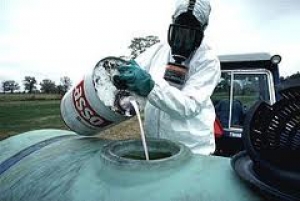Dairy Management
Controlling Insects, Rodents for Healthy Livestock

Cattle in both pasture and confinement situations are affected by flies, as are poultry, said Ralph Williams.
Bloodsucking flies literally drain animals' lifeblood, and all flies can transmit diseases, cause discomfort and create a nuisance for neighbors. Pastured cattle are mainly targeted by the face fly, which feeds on cattle's mucous membranes and can transmit pink eye.
Another pest in pastured cattle is the parasitic horn fly, which lives its entire adult life drinking the blood of one animal.
Control of pasture pests typically consists of self-application devices such as dust bags, oilers, pour-on products, and insecticide ear tags, Williams said.
Ear tags have two types of ingredients - pyrethroid and organophosphate. Pyrethroid tags are most effective on face flies. Some horn flies have developed a genetic resistance to pyrethroid, and in this case, horn flies may respond better to organophosphate tags or to a pour-on insecticide.
Williams advised that producers try ear tags first, and if they are not effective, then to turn to alternative treatments. In confinement operations, cattle are frequently bothered by the housefly, which causes irritation and can transmit diseases, and the bloodsucking stable fly, which directly reduces weight gain and milk production.
Any efforts to control these flies must begin with effective manure management, Williams said.
"House and stable flies breed in manure, so proper procedures to minimize their breeding will go a long way in reducing these fly pests," he said.
"There are some things you can do to the flies themselves - fly bait, aerosol knockdown sprays, residual insecticides - but without proper manure management, they won't do much good."
This same advice applies to poultry operations, where houseflies also are a major problem.
While they do not pose a serious health threat to the birds, they can become a major nuisance to neighbors.
Poultry owners can track houseflies by using "spot" or "speck" cards, which are simply 3-by-5-inch index cards fastened in several places around a hen house or building.
Flies will leave fluid spots on the cards, and the number of spots on the card will provide a rough estimate of how many flies pass through the hen house in a given period. Generally, an average of 100 spots per day indicates a serious fly problem.
Another poultry pest to watch for is the northern fowl mite, a bloodsucking parasite. Northern fowl mites have made a strong comeback in recent years, Williams said, and they can seriously affect on egg production. Treatment consists of high-pressure sprays directed into the birds' cages, so they are difficult to treat in large operations.
One of the most destructive poultry pests is the house mouse.
Mice can transmit salmonella, and their chewing can cause significant destruction of facilities and equipment.
"Controlling mice requires a yearlong program consisting of constant surveillance and traps," Williams said.
"There can be several mouse 'families' in any facility, so poison should be spaced every 30 feet or so. Prevent feed spills, keep bait exposed, and use traps to monitor populations, because mice will be a problem if ignored."





















